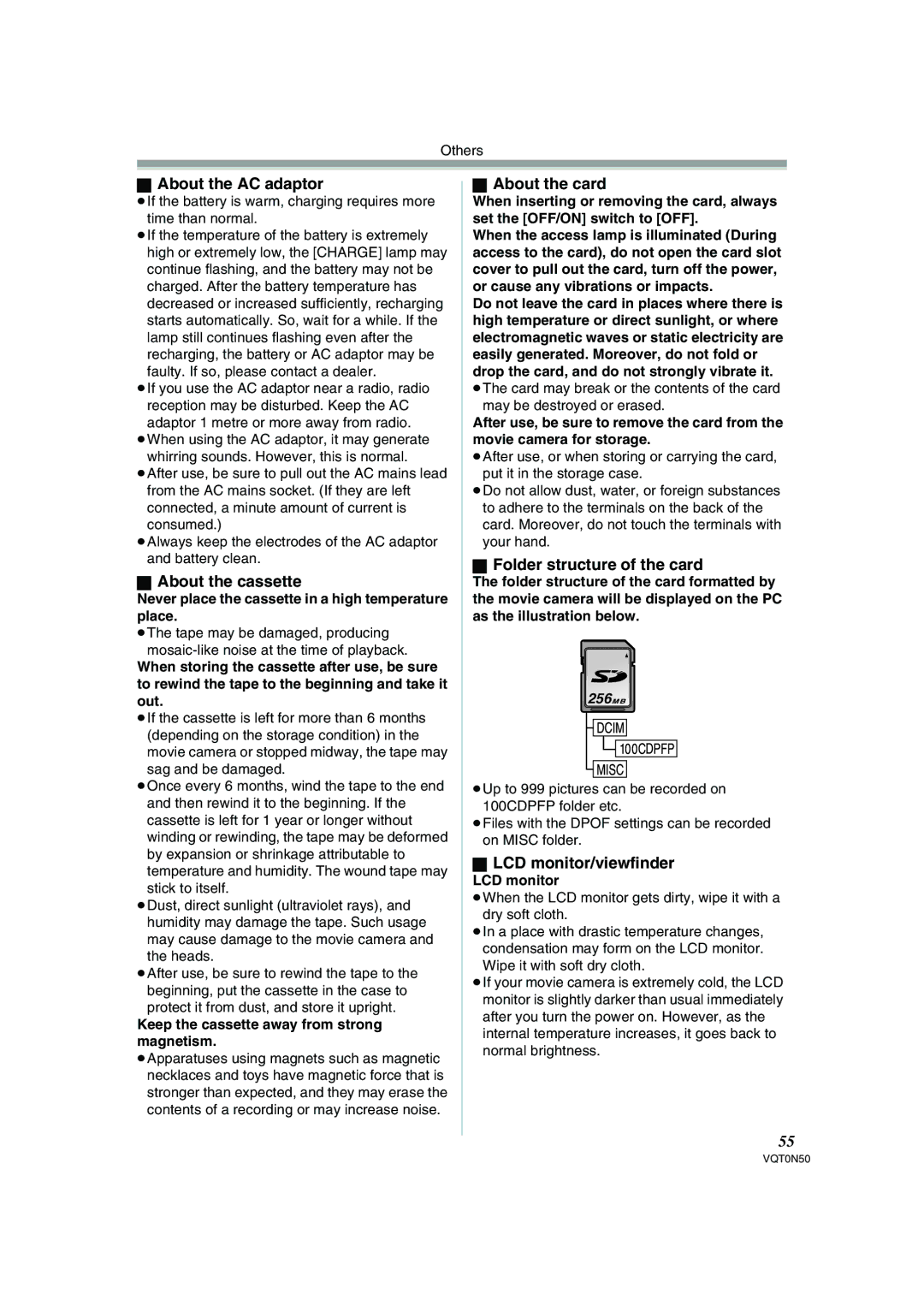
Others
ªAbout the AC adaptor
≥If the battery is warm, charging requires more time than normal.
≥If the temperature of the battery is extremely high or extremely low, the [CHARGE] lamp may continue flashing, and the battery may not be charged. After the battery temperature has decreased or increased sufficiently, recharging starts automatically. So, wait for a while. If the lamp still continues flashing even after the recharging, the battery or AC adaptor may be faulty. If so, please contact a dealer.
≥If you use the AC adaptor near a radio, radio
reception may be disturbed. Keep the AC adaptor 1 metre or more away from radio.
≥When using the AC adaptor, it may generate whirring sounds. However, this is normal.
≥After use, be sure to pull out the AC mains lead from the AC mains socket. (If they are left
connected, a minute amount of current is consumed.)
≥Always keep the electrodes of the AC adaptor and battery clean.
ªAbout the cassette
Never place the cassette in a high temperature place.
≥The tape may be damaged, producing
When storing the cassette after use, be sure to rewind the tape to the beginning and take it out.
≥If the cassette is left for more than 6 months
(depending on the storage condition) in the movie camera or stopped midway, the tape may sag and be damaged.
≥Once every 6 months, wind the tape to the end and then rewind it to the beginning. If the cassette is left for 1 year or longer without winding or rewinding, the tape may be deformed by expansion or shrinkage attributable to temperature and humidity. The wound tape may stick to itself.
≥Dust, direct sunlight (ultraviolet rays), and humidity may damage the tape. Such usage may cause damage to the movie camera and the heads.
≥After use, be sure to rewind the tape to the beginning, put the cassette in the case to
protect it from dust, and store it upright.
Keep the cassette away from strong magnetism.
≥Apparatuses using magnets such as magnetic necklaces and toys have magnetic force that is stronger than expected, and they may erase the contents of a recording or may increase noise.
ªAbout the card
When inserting or removing the card, always set the [OFF/ON] switch to [OFF].
When the access lamp is illuminated (During access to the card), do not open the card slot cover to pull out the card, turn off the power, or cause any vibrations or impacts.
Do not leave the card in places where there is high temperature or direct sunlight, or where electromagnetic waves or static electricity are easily generated. Moreover, do not fold or drop the card, and do not strongly vibrate it. ≥The card may break or the contents of the card
may be destroyed or erased.
After use, be sure to remove the card from the movie camera for storage.
≥After use, or when storing or carrying the card,
put it in the storage case.
≥Do not allow dust, water, or foreign substances to adhere to the terminals on the back of the card. Moreover, do not touch the terminals with your hand.
ªFolder structure of the card
The folder structure of the card formatted by the movie camera will be displayed on the PC as the illustration below.
256
≥Up to 999 pictures can be recorded on 100CDPFP folder etc.
≥Files with the DPOF settings can be recorded on MISC folder.
ªLCD monitor/viewfinder
LCD monitor
≥When the LCD monitor gets dirty, wipe it with a dry soft cloth.
≥In a place with drastic temperature changes, condensation may form on the LCD monitor. Wipe it with soft dry cloth.
≥If your movie camera is extremely cold, the LCD monitor is slightly darker than usual immediately after you turn the power on. However, as the internal temperature increases, it goes back to normal brightness.
55
VQT0N50
